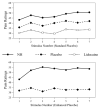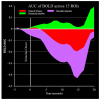Enhancing the placebo response: functional magnetic resonance imaging evidence of memory and semantic processing in placebo analgesia
- PMID: 24412799
- PMCID: PMC4004374
- DOI: 10.1016/j.jpain.2013.12.009
Enhancing the placebo response: functional magnetic resonance imaging evidence of memory and semantic processing in placebo analgesia
Abstract
Two groups of patients with irritable bowel syndrome rated pain and underwent functional magnetic resonance imaging brain scanning during experimentally induced rectal distension (20 seconds, 7 stimuli). Group 1 was tested under baseline (natural history [NH]) and a verbally induced placebo condition, whereas Group 2 was tested under baseline and standard placebo (no verbal suggestion for pain reduction) and intrarectal lidocaine conditions. As hypothesized, intrarectal lidocaine reduced evoked pain and pain-related brain activity within Group 2. Between-group comparisons showed that adding a verbal suggestion to a placebo condition increased neural activity involved in memory and semantic processing, areas that process the placebo suggestions. These areas, in turn, are likely to influence brain areas involved in emotions and analgesia and consequently the placebo effect. These placebo suggestions also added significant decreases in activity of brain areas that process pain. The test stimulus itself seems to cue these effects and is consistent with previous explanations that somatic focus and sensory feedback reinforce expectations and other factors that mediate placebo analgesic effects.
Perspective: Expectations for pain can be verbally manipulated to produce placebo analgesia. Placebo analgesia is accompanied by decreased brain activity related to processing pain and increased brain activity that generates placebo analgesia, including semantic and memory regions. Placebo suggestions may enhance placebo analgesia by engaging a feedback mechanism triggered by the painful stimulus itself and related to brain mechanisms involved in memory and semantic processing.
Keywords: Placebo analgesia; brain imaging; expectations; irritable bowel syndrome; nociception; pain.
Published by Elsevier Inc.
Figures






References
-
- Atlas LY, Wager TD. How expectations shape pain. Neurosci Lett. 2012;520:140–148. - PubMed
-
- Bar M, Aminoff E, Mason M, Fenske M. The units of thought. Hippocampus. 2007;17:420–428. - PubMed
-
- Benedetti F, Amanzio M. Mechanisms of the placebo response. Pulmonary pharmacology & therapeutics. 2013 - PubMed
Publication types
MeSH terms
Grants and funding
LinkOut - more resources
Full Text Sources
Other Literature Sources
Medical
Research Materials

